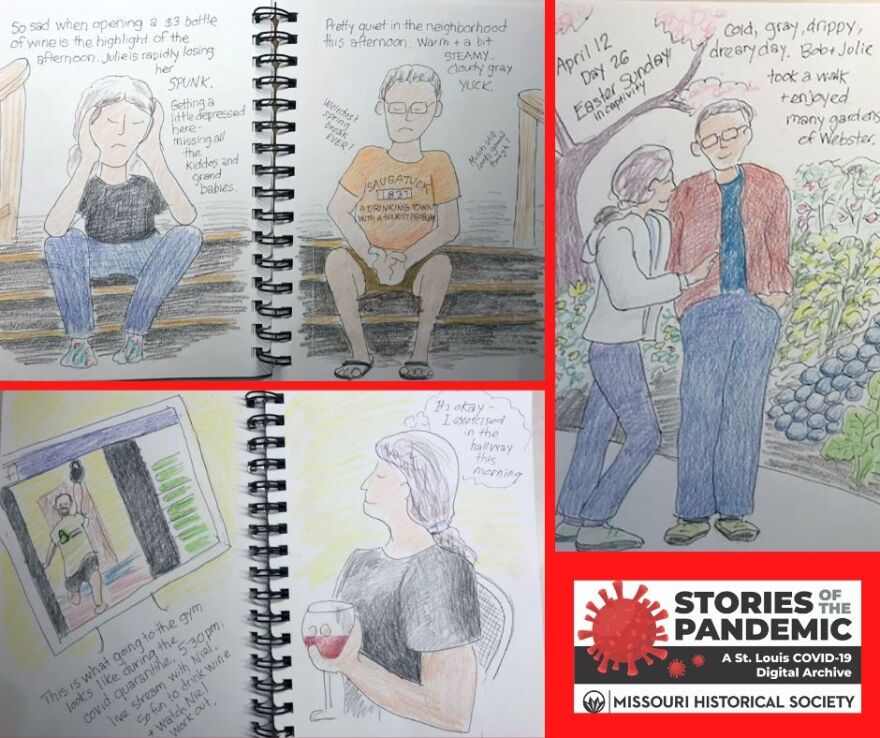Susan Stitch's last few months can be summed up in a wedding photo. In April, Stitch captured her daughter Sammi and her husband, Chris Beseau, as they shared a kiss at the Cottleville Wine Seller. Both wore face masks and gloves.
The wedding was an intimate affair that went through last-minute booking changes as the coronavirus pandemic started to sweep through the St. Louis and St. Charles areas and prohibited large gatherings.
“We had one daughter who was there as a bridesmaid, and the minister and his wife,” said Stitch of St. Charles. “We were less than 10 people and set up a few chairs.”
The couple's wedding is now a part of St. Louis history, along with more than 200 other coronavirus moments captured by the Missouri Historical Society.
Stories of the Pandemic make up the latest archive from the Missouri Historical Society. The organization has been collecting artifacts documenting how St. Louisans have dealt with the pandemic and how it has affected their lives.
Curators from the Missouri Historical Society started discussing how they should approach this moment in March as the region was beginning to shut down under stay-at-home orders aimed at preventing the virus from spreading. When they thought about what they wanted to accomplish, curators examined the artifacts collected from two other pandemics, the 1840s cholera outbreak and the 1918 Spanish flu.
“They captured so many interesting stories and diaries and letters, people were feeling the same kinds of emotion that we're feeling today, and they were unsure how this was going to play out,” said Angie Dietz, the society’s director of digital initiatives. “We just thought there's going to be so many important stories and tales coming out of this particular moment that we're going to find some way to capture this.”
Dietz said objects collected from the cholera outbreak and the 1918 Spanish flu collected by the society created the blueprint for the kinds of stories the organization wanted to find during this pandemic. The organization has made it a priority to collect personal accounts that paint a realistic portrait of everyday life, said Hattie Felton, the historical society's senior curator.
“For us, it's really, you know, it's really about local storytelling,” Felton said. “Collecting local objects really allows us to share the story of our region's unique response and resilience at this moment in time.”

Felton and Dietz say people have come up with creative ways to document the pandemic: A grandmother illustrated a comic book for her grandchildren documenting her time quarantined. Another family invented a coronavirus board game to pass the time.
Felton said curators also plan to collect toilet paper rolls, gloves, masks and other items in demand during the pandemic.
People in the St. Louis region who collected those items sent photos of them to the museum's digital archive. Curators plan to pick up as many items as possible when it's safe to visit homes.
Other submissions focus on individuals and how they’ve been coping. Local photographer Lou Bopp submitted a collection of photos to the historical society showing business owners and families adapting to the pandemic. His favorite shows his daughter holding their dog and looking out their door.
“We were supposed to be on spring break at that time,” Bopp said. “Life stops, she couldn't go outside, she couldn't see her friends. That's the one that really gets to me because her expression just sitting there and you know, as a parent is, it’s pretty poignant.”
That picture is part of the project’s digital archive. It includes photos, videos, audio, journal entries and musical recordings from St. Louisans who’ve documented their experiences.

Many of the submissions show St. Louisans trying to make the best of circumstances. But others are somber, Dietz said.
“We've had a few posts about people having to do funerals through Zoom or FaceTime through online means, so those have been particularly sad,” Dietz said. “People haven't been able to come together in the way they typically were to grieve the loss of a loved one.”
Dietz and Felton said it’s difficult capturing artifacts from an historic event while living it. Felton said they’ll continue collecting artifacts for years to come, and some can be used by the museum in a future exhibit.
“I could see that these would make their way into future exhibitions in the near future, and for us the near future is not necessarily the next few months, but more years,” Felton said.
They’re documenting history as it happens, and someday, Susan Stitch and her family might be able to relive their experiences by visiting the exhibit.
“I thought that that would be fun to be part of a historical record of things that happened for the kids,” Stitch said. “Someday they can take their grandkids and maybe see the picture at the museum.”
Follow Chad on Twitter @iamcdavis
Send questions and comments about this story to feedback@stlpublicradio.org




